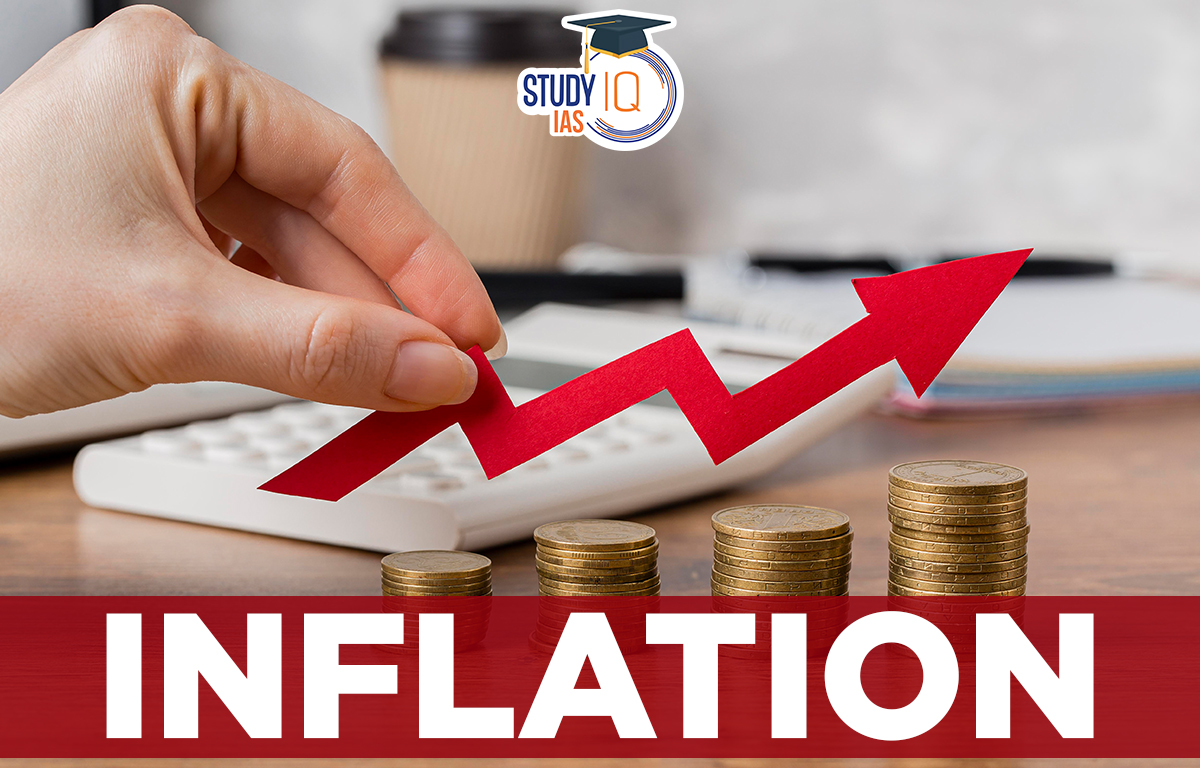Table of Contents
Context: RBI said core inflation is falling but food price fluctuations are affecting the RBI’s monetary policy and their 4% target. Vegetable price drops during winter were minimal and temporary, with cereal, meat, and fish prices experiencing increases.
What is Core Inflation?
Core inflation refers to the change in the costs of goods and services, excluding those from the food and energy sectors. These two components—food and energy—are intentionally left out of core inflation calculations because their prices tend to be highly volatile and can fluctuate significantly over short periods.
Significance of Core inflation
- Core inflation is crucial because it helps policymakers, economists, and analysts understand the impact of rising prices on consumer income.
- Policymakers use core inflation to make informed decisions about interest rates and fiscal policies. A stable and reliable measure of inflation trends allows for effective decision-making, promoting economic stability and growth.
- It’s a crucial tool for central banks to assess and adjust monetary policy, as it reflects underlying inflation trends without temporary shocks.
Read this article below to learn all about Inflation, its causes and its impacts on the economy in detail.
Inflation
Inflation is an economic concept that refers to the rise in prices of goods and services over time. It is an important indicator of the health of an economy and can have a significant impact on the purchasing power of individuals and businesses.
Inflation is measured using various indices, including the Consumer Price Index (CPI) and the Wholesale Price Index (WPI). Understanding inflation is crucial for policymakers, businesses, and individuals to make informed decisions about investments, savings, and economic policies.
Inflation Rate in India
In India, the inflation rate is measured using the Consumer Price Index (CPI) which tracks the change in the price of a basket of goods and services consumed by households. The inflation rate is calculated as the percentage change in the CPI over a specific period.
Over the past few decades, India has experienced fluctuations in the inflation rate. In the early 2000s, inflation was relatively high, with the average annual rate hovering around 6-7%. However, in the mid-2000s, there was a significant decline in inflation, with the rate falling to around 3-4%. This was due to several factors, including a decline in global oil prices and the implementation of several economic reforms.
In recent years, there has been an increase in inflation in India, with the rate hovering around 5-6%. This has been attributed to several factors, including rising food and fuel prices, supply chain disruptions caused by the COVID-19 pandemic, and increased government spending.
What Is CPI Inflation?
- The consumer price index measures “changes over time in the general level of prices of a basket of selected goods and services that households acquire for consumption.” – Ministry of Statistics and Programme Implementation (MoSPI).
- It is released monthly by the National Statistical Office (NSO), Ministry of Statistics and Programme Implementation (MoSPI).
- At an all-India level, the current CPI basket comprises 299 items.
- Base Year: It is a reference point used for comparison to measure changes in price levels over time. The current base year is 2012.
What Are the Components of CPI Inflation?
The Consumer Price Index (CPI) comprises six primary categories, each with different importance and various subcategories. These main components are:
- Food and Beverages: This is the most significant section, accounting for 45% of the total index. Within this, cereal prices are particularly influential, making up 67% of the CPI.
- Pan, Tobacco, and Intoxicants: This category includes items like pan, tobacco products, and various intoxicants.
- Clothing and Footwear: This segment covers all types of apparel and footwear items.
- Housing: This component reflects costs associated with housing, such as rent.
- Fuel and Light: This includes expenses for energy sources like electricity and fuel.
- Miscellaneous: This diverse category encompasses services like education and healthcare, and it’s the second most significant component after food and beverages.
Causes of Inflation
Several factors can cause inflation, including:
Increase in Demand
When the demand for goods and services in an economy increases, it can cause inflation because there are not enough goods and services to meet the demand. As a result, prices go up. For example, if there is a sudden increase in demand for housing in a city, the prices of houses will go up, causing inflation.
Increase in Production Costs
When the cost of producing goods and services goes up, it can cause inflation. This is because producers pass on the higher production costs to consumers in the form of higher prices. For example, if the cost of oil increases, it will increase the cost of production for many industries, leading to higher prices for goods and services.
Increase in the Money Supply
When there is too much money in circulation in an economy, it can cause inflation because the excess money chases too few goods and services, leading to higher prices. For example, if the government prints too much money, it can cause inflation.
Decrease in the Supply of Goods and Services
When there is a decrease in the supply of goods and services in an economy, it can cause inflation because there are not enough goods and services to meet the demand. For example, if a natural disaster destroys a large portion of the food supply, it will lead to higher prices for food, causing inflation.
Expectations of Inflation
When people expect inflation to occur in the future, it can cause inflation in the present. This is because people start to buy goods and services now, anticipating that they will become more expensive in the future, leading to higher demand and higher prices. For example, if people expect inflation to occur, they may buy more goods and services now, leading to higher prices.
Impacts of Inflation
Inflation can have various impacts on the economy, individuals, and businesses. Some of the impacts of inflation are:
Decreased Purchasing Power
Inflation decreases the purchasing power of money. As the general price level increases, the same amount of money can buy fewer goods and services. For example, if a person has $100, and inflation increases the price level by 10%, the person will be able to buy only 90% of the goods and services they could have purchased before the inflation.
Reduced Savings
Inflation can reduce the value of savings because the value of money decreases over time. For example, if a person saves $1000 in a savings account that pays an interest rate of 2%, but inflation increases by 4%, the real value of the savings account will decrease over time.
Increased Costs for Businesses
Inflation can increase the costs for businesses as they have to pay more for raw materials, labour, and other inputs. This can reduce their profit margins and make it difficult for them to remain competitive. For example, if the cost of oil increases, it can increase the transportation costs for businesses, leading to higher prices for goods and services.
Redistribution of Income and Wealth
Inflation can redistribute income and wealth in an economy. Those who have fixed incomes, such as pensioners or low-income earners, may find it difficult to cope with the rising prices, whereas those who have assets that appreciate during inflation, such as property or stocks, may benefit.
Uncertainty
Inflation can create uncertainty in the economy, which can discourage businesses from investing and individuals from spending. For example, if people expect inflation to increase in the future, they may hold off on making purchases, leading to decreased economic activity.
Inflation and Deflation
Inflation is a sustained increase in the general price level of goods and services, while deflation is a sustained decrease in the general price level of goods and services. Inflation reduces the purchasing power of money, while deflation increases the purchasing power of money. Both can have significant impacts on the economy and individuals.
Inflation in India UPSC
Inflation is an important topic for the UPSC (Union Public Service Commission) exam as it is a part of the UPSC Syllabus for both the prelims and mains exam. The UPSC exam is one of the most competitive exams in India, and the syllabus covers a wide range of topics related to the Indian economy, including inflation.
Aspirants who are preparing for the UPSC exam can benefit from studying inflation as it helps them to understand the functioning of the Indian economy and its impact on various sectors. Moreover, the UPSC exam requires a deep understanding of current affairs, and inflation is a topic that is constantly in the news and affects the lives of people.
UPSC aspirants can access various online coaching platforms such as StudyIQ UPSC Online Coaching, which provides comprehensive study material and video lectures on topics related to the UPSC syllabus, including inflation. Additionally, the UPSC Mock Test and the previous year’s question papers can also be useful in understanding the exam pattern and preparing for the exam effectively.
| Other Important Articles | |
| GDP of Indian States | Types of Bank Accounts |
| Types of Banks in India | India’s GDP Growth Rate |
| List of RBI Governors of India |
Indian Financial System |


 Cat Bonds (Catastrophe Bonds), Meaning, ...
Cat Bonds (Catastrophe Bonds), Meaning, ...
 What is Visible and Invisible Trade with...
What is Visible and Invisible Trade with...
 Chemical Industry in India: Powering Ind...
Chemical Industry in India: Powering Ind...





















